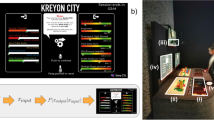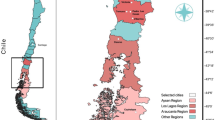Abstract
While the scientific community documents environmental degradation and develops scenarios to identify the operational margins of system Earth, less attention is given to how decisions are made that steer the system in one direction or the other. We propose to use strategy games for this purpose, increasing the representation of human agency in scenario development and creating spaces for deliberation between different worldviews. Played by the right people, strategy games could help break free from established norms and support more transparent democratic dialogues, responding to the human and social limitations of current decision-making. The question is, who gets to play?
This is a preview of subscription content, access via your institution
Access options
Access Nature and 54 other Nature Portfolio journals
Get Nature+, our best-value online-access subscription
$29.99 / 30 days
cancel any time
Subscribe to this journal
Receive 12 digital issues and online access to articles
$119.00 per year
only $9.92 per issue
Buy this article
- Purchase on Springer Link
- Instant access to full article PDF
Prices may be subject to local taxes which are calculated during checkout


Similar content being viewed by others
References
Díaz, S. et al. Pervasive human-driven decline of life on Earth points to the need for transformative change. Science 366, eaax3100 (2019).
Díaz, S. et al. Summary for Policymakers of the Global Assessment Report on Biodiversity and Ecosystem Services of the Intergovernmental Science-Policy Platform on Biodiversity and Ecosystem Services (IPBES Secretariat, 2019).
Global Biodiversity Outlook 5 (Secretariat of the Convention on Biological Diversity, 2020).
Leclère, D. et al. Bending the curve of terrestrial biodiversity needs an integrated strategy. Nature 585, 551–556 (2020).
Waeber, P. O. et al. Choices we make in times of crisis. Sustainability 13, 3578 (2021).
Nyborg, K. et al. Social norms as solutions. Science 354, 42–43 (2016).
Xu, H. et al. Ensuring effective implementation of the post-2020 global biodiversity targets. Nat. Ecol. Evol. https://doi.org/10.1038/s41559-020-01375-y (2021).
Díaz, S. et al. Set ambitious goals for biodiversity and sustainability. Science 370, 411–413 (2020).
van Soest, H. L. et al. Analysing interactions among sustainable development goals with integrated assessment models. Glob. Transit. 1, 210–225 (2019).
McLaren, D. & Markusson, N. The co-evolution of technological promises, modelling, policies and climate change targets. Nat. Clim. Change 10, 392–397 (2020).
Araújo, M. B. et al. Standards for distribution models in biodiversity assessments. Sci. Adv. 5, eaat4858 (2019).
Pereira, L. M. et al. Developing multiscale and integrative nature–people scenarios using the Nature Futures Framework. People Nat. 2, 1172–1195 (2020).
Preston, B. L. et al. Scale and the representation of human agency in the modeling of agroecosystems. Curr. Opin. Environ. Sustain. 14, 239–249 (2015).
Otto, I. M. et al. Human agency in the Anthropocene. Ecol. Econ. 167, 106463 (2020).
Saltelli, A. et al. Five ways to ensure that models serve society: a manifesto. Nature 582, 482–484 (2020).
Redpath, S. M. et al. Games as tools to address conservation conflicts. Trends Ecol. Evol. 33, 415–426 (2018).
Speelman, E. N. et al. Serious gaming as a tool to facilitate inclusive business; a review of untapped potential. Curr. Opin. Environ. Sustain. 41, 31–37 (2019).
Rooney-Varga, J. N. et al. Combining role-play with interactive simulation to motivate informed climate action: evidence from the World Climate simulation. PLoS ONE 13, e0202877 (2018).
Garcia, C. A. et al. The global forest transition as a human affair. One Earth 2, 417–428 (2020).
Roese, N. J. & Epstude, K. in Advances in Experimental Social Psychology Vol. 56 (ed. Olson, J. M.) 1–79 (Academic Press, 2017).
Fernbach, P. M. et al. Political extremism is supported by an illusion of understanding. Psychol. Sci. 24, 939–946 (2013).
Reddie, A. W. et al. Next-generation wargames. Science 362, 1362–1364 (2018).
Lofgren, E. T. & Fefferman, N. H. The untapped potential of virtual game worlds to shed light on real world epidemics. Lancet Infect. Dis. 7, 625–629 (2007).
Kleinschroth, F., Garcia, C. & Ghazoul, J. Reconciling certification and intact forest landscape conservation. Ambio 48, 153–159 (2019).
Kamto, M. et al. Using role-play to explore strategies for improving palm oil production and sustainability in Cameroon. ETFRN NEWS 139 (accessed 25 September 2021).
Grantham, H. S. et al. Anthropogenic modification of forests means only 40% of remaining forests have high ecosystem integrity. Nat. Commun. 11, 5978 (2020).
Vennix, J. A. M. Group model-building: tackling messy problems. Syst. Dyn. Rev. 15, 379–401 (1999).
Biggs, D. et al. The implementation crisis in conservation planning: could ‘mental models’ help? Conserv. Lett. 4, 169–183 (2011).
Kelly, G. A. The Psychology of Personal Constructs: Clinical Diagnosis and Psychotherapy (Routledge, 2003).
Marengo, L. & Zeppini, P. The arrival of the new. J. Evol. Econ. 26, 171–194 (2016).
Kremer, M. & Debo, L. Inferring quality from wait time. Manage. Sci. 62, 3023–3038 (2016).
Chong, D. et al. When self‐interest matters. Polit. Psychol. 22, 541–570 (2001).
Garcia, C. A. et al. Coffee, farmers, and trees—shifting rights accelerates changing landscapes. Forests 11, 480 (2020).
Wittgenstein, L. Tractatus Logico-Philosophicus English edn first published in 1922 (Routledge, 2019).
Fauvelle, E. & Garcia, C. AgriForEst: un jeu pour élaborer des scénarios sur un terroir villageois d’Afrique Centrale. VertigO https://doi.org/10.4000/vertigo.23245 (2018).
Festinger, L. A Theory of Cognitive Dissonance Vol. 2 (Stanford Univ. Press, 1962).
Schmierbach, M. et al. No one likes to lose. J. Media Psychol. 26, 105–110 (2014).
Wood, S. L. & Lynch, J. G. Jr Prior knowledge and complacency in new product learning. J. Consum. Res. 29, 416–426 (2002).
Ottati, V. et al. When self-perceptions of expertise increase closed-minded cognition: the earned dogmatism effect. J. Exp. Soc. Psychol. 61, 131–138 (2015).
Mermet, L. Strategic Environmental Management Analysis: Addressing the Blind Spots of Collaborative Approaches. Collection Idées pour le débat 5 (IDDRI, 2011).
Barnaud, C. et al. in Companion Modelling (ed. Étienne, M.) 127–153 (Springer, 2014).
Ferris, F. D., von Gunten, C. F. & Emanuel, L. L. Knowledge: insufficient for change. J. Palliat. Med. 4, 145–147 (2001).
Chen, W. J. & Krajbich, I. Computational modeling of epiphany learning. Proc. Natl Acad. Sci. USA 114, 4637–4642 (2017).
Castelfranchi, C. Mind as an anticipatory device: for a theory of expectations. In International Symposium on Brain, Vision, and Artificial Intelligence (eds De Gregorio, M. et al.) 258–276 (Springer, 2005).
Garcia, C., Dray, A. & Waeber, P. Learning begins when the game is over: using games to embrace complexity in natural resources management. GAIA Ecol. Perspect. Sci. Soc. 25, 289–291 (2016).
Arnstein, S. R. A ladder of citizen participation. J. Am. Plann. Assoc. 35, 216–224 (1969).
Nielsen, K. S. et al. The role of high-socioeconomic-status people in locking in or rapidly reducing energy-driven greenhouse gas emissions. Nat. Energy https://doi.org/10.1038/s41560-021-00900-y (2021).
Bandura, A. Toward a psychology of human agency. Perspect. Psychol. Sci. 1, 164–180 (2006).
Le Page, C. et al. Exploring how knowledge and communication influence natural resources management with ReHab. Simul. Gaming 47, 257–284 (2016).
Geist, H. J. & Lambin, E. F. Proximate causes and underlying driving forces of tropical deforestation; tropical forests are disappearing as the result of many pressures, both local and regional, acting in various combinations in different geographical locations. BioScience 52, 143–150 (2002).
Meyfroidt, P. et al. Middle-range theories of land system change. Glob. Environ. Change 53, 52–67 (2018).
Bastin, J. F. et al. The global tree restoration potential. Science 365, 76–79 (2019).
Kleinschroth, F. & Healey, J. R. Impacts of logging roads on tropical forests. Biotropica 49, 620–635 (2017).
Pea, R.D. in Distributed Cognitions: Psychological and Educational Considerations (ed. Salomon, G.) 47–87 (Cambridge Univ. Press, 1993).
Dudman, K. & de Wit, S. An IPCC that listens: introducing reciprocity to climate change communication. Clim. Change 168, 2 (2021).
Garcia, C., Cornioley, T., Chamagne, J. & Dillmann, C. Defining Indicators for Intact Forest Landscapes in the Congo Basin by Using a Role-Playing Game (FSC, 2017); https://doi.org/10.13140/RG.2.2.29544.16645
Acknowledgements
We thank S. Mazas for designing the illustrations; the Forest Stewardship Council Congo Basin Office, its former director M. Auger-Schwartzenberg and his colleagues O. Rickenbach and W. Lawyer for entrusting us with the facilitation of the Regional Working Group on High Conservation Values (HCV-RWG) session in Brazzaville in 2017; and H. Vellema, R. Jezeer, E. Speelman and A. Fellay for their support. The empirical examples given here stem from the work of the CoForTips project (ANR‐12‐EBID‐0002) funded by the ERA-NET BiodivERsA, with the national funders ANR, BELSPO and FWF, as part of the 2012 call for research proposals, and the OPAL project financed by the Swiss National Science Foundation (r4d-Ecosystems) grant no. 152019. The MineSet model was developed by the CoForSet project, funded by the FRB 2013 call for research proposals 'Scenarios of Biodiversity for Sub-Saharan Africa', with support by the FFEM. MineSet was tested by Tropenbos International at their offices in Wageningen.
Author information
Authors and Affiliations
Contributions
C.A.G. and P.O.W. developed the initial draft. S.S., R.W.V., S.A.S., P.F., G.D.P. and M.BA. contributed to improving the draft. All other authors contributed to revising the manuscript. This Perspective builds on the discussions previously held by the authors in the development of two papers: Garcia et al.19 and Waeber et al.5.
Corresponding authors
Ethics declarations
Competing interests
L.B., P.S., L.F. and H.D. work for CIRAD, a French public research centre. C.A.G., P.O.W. and A.D. are shareholders of LEAF Inspiring Change (https://leafic.ch/), a Swiss spin-off of ETH. F.Q. works for Biotope (https://www.biotope.fr/), a French consultancy company. CIRAD, LEAF and Biotope all offer, among other consultancy services, the use of strategy games to clients in the public and private sectors.
Peer review
Peer review information
Nature Sustainability thanks Meine van Noordwijk, Glenn Wright and the other, anonymous, reviewer(s) for their contribution to the peer review of this work.
Additional information
Publisher’s note Springer Nature remains neutral with regard to jurisdictional claims in published maps and institutional affiliations.
Supplementary information
Supplementary Information
Supplementary Note 1: Axiology; Supplementary Note 2: Letter from FSC.
Supplementary Video 1
Tropenbos International organized a full-day demonstration of the MineSet game in 2017. The video shows a time-lapse of the board as it changes through the game. Players take the role of logging and mining companies, securing concession rights, developing roads, extracting timber and interacting with local communities. With the development of human activities, dense forests (dark green hexagons) are fragmented and opened (light green) and eventually transform into mosaïc landscapes with crops, infrastructures and trees (yellow). That is, unless players sustainably manage the forest resources and the landscape. The session report is accessible here and https://doi.org/10.13140/RG.2.2.26134.24644.
Supplementary Video 2
The issue of palm oil is controversial and complex. Simple answers will not help transform the supply chain. How to convey this complexity without drowning people with facts and figures? This small animation video presents the supply chain in Cameroon as it is described in the CoPalCam Game. Designed by Sylvain Mazas and Claude Garcia, the clip lists the different issues stakeholders are confronted with—from the risks of losing a crop to the reduced efficiency of the artisanal mills. Details on the use of the game are available at opal-project.org/.
Rights and permissions
About this article
Cite this article
Garcia, C.A., Savilaakso, S., Verburg, R.W. et al. Strategy games to improve environmental policymaking. Nat Sustain 5, 464–471 (2022). https://doi.org/10.1038/s41893-022-00881-0
Received:
Accepted:
Published:
Issue Date:
DOI: https://doi.org/10.1038/s41893-022-00881-0



